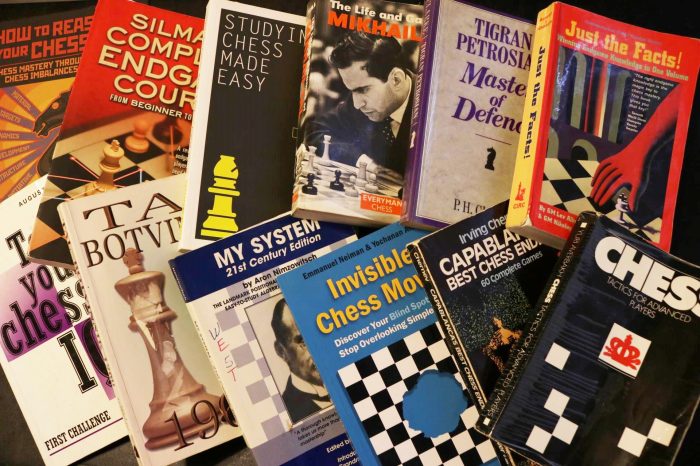 In the comments for a previous article, a reader, Chris Farmer, asked:
In the comments for a previous article, a reader, Chris Farmer, asked:
"I’m curious about the pre-tourney prep you do and any advice you might have for a player who has been stuck at the 2nd Category level for years despite blood, sweat and tears. Which book and/or player made an impression on you? I’m more than halfway through Mikhail Tal’s autobiography and Python Strategy by Petrosian is on my wishlist!"
I can trace nearly every peak rating I’ve ever had to time spent studying a specific book. A good chess book holds an entire world of understanding within its pages. It’s hard to put down, full of entertaining prose and fascinating games. Ideally, when you’re about midway through, you start to see its effect on your own games. You notice things you didn’t before. If it’s a Tal book, suddenly, you find intriguing opportunities to sacrifice at every turn. If it’s a tactics book, your pieces begin to come alive at the hint of a loose piece in the enemy position. If it’s a positional text, it becomes second nature to hunt down your opponent’s weak pawns. How do you choose the books that will help you improve the most? And, is there an optimum way to study? While there is no shortage of chess books, many of which are excellently-written, remembering and using the knowledge consistently in your own games can be another story. These are the training methods and materials that have helped me improve the most over the years---with an emphasis on the 1500-1900 level:
1) Study actively.
Every time I study, I make the process interactive: the more I’m thinking, solving, and re-creating tournament conditions, the better I’ll remember, understand, and be able to use the knowledge in the future.
When solving tactics and puzzles:
- Set-up the position on a real board. I try to make my study sessions as close to tournament conditions as possible. Even if you use an online program, such as chess.com’s Tactics Trainer or ChessTempo, I recommend setting up the positions.
- Time yourself with a chess clock. Depending on the position’s difficulty, I choose a maximum amount of time I’d want myself to spend on that type of position in a competitive game.
- Write down your answer (at least the main idea). This habit encourages me to think through my variations completely and makes me less tempted to check the answer when my ideas are incomplete.
“If you write down your solutions, you are accountable to yourself for the quality of your decision-making, especially whether you saw the most important details needed to make the right decision. Luck is not a factor to rely on and neither is its cousin guessing!” -Jacob Aagaard, Grandmaster Preparation: Attack & Defense
- Don’t give up until you’re solved the tactic completely or your time runs out.
“You are solving a puzzle and think you have the solution but there is something ‘fuzzy’ in one of the lines---so instead of insisting on being sure (forcing your brain to calculate deeper), you check the solution (doh!).” -GM Sune Berg Hansen, Grandmaster Preparation: Attack & Defense
Make sure you’ve analyzed the position as much as you can before turning to the answer key. The habits you train will stay with you in your tournament games. If you push yourself to try harder to solve challenging exercises, you’ll be prepared to do so over the board.
- What if I fail to solve a puzzle?
If you reach the end of your time, have tried your best, and still haven’t found the answer, it may be a pattern or an idea that’s new to you. Or it might be a familiar pattern, but some other feature of the position consumed your attention instead.
- Go through the answer in detail.
- Pay attention to what you missed.
- Make a note---You might find a certain type of move or tactical theme that you consistently miss in puzzles.
For example, backwards knight movements are particularly easy to overlook. Here's a famous example of chess tactical blindness where a World Champion missed a checkmate in one move.
[pgn][Event "?"] [Site "?"] [Date "????.??.??"] [Round "?"] [White "Deep Fritz 10"] [Black "Kramnik, Vladimir"] [Result "1-0"] [ECO "D10"] [BlackElo "2750"] [SetUp "1"] [FEN "5N1k/q5p1/7p/4P3/pp2Q3/8/1P4PP/2b4K b - - 0 34"] [PlyCount "2"] [EventDate "2006.11.25"] [EventType "match"] [EventRounds "6"] [Source "ChessBase"] [SourceDate "2007.02.01"]{In this advantageous position, Kramnik played} 34... Qe3 $4 {missing the simple} 35. Qh7# 1-0[/pgn]
It's easy to dismiss a moment like this as a fluke. In many ways, it was---in another thousand games, Kramnik most likely wouldn't miss mate in one even once. However, the unique feature in this position (the knight guarding the checkmating square in such an unusual way) may reveal a tactical blind spot. If you find a blind spot, study materials that focus more extensively on that type of move or theme. For a particular tactical theme, there are many books, including a few I list below. For particular types of moves, such as backwards knight moves or rook circuits, Invisible Chess Moves by Emmanuel Neiman and Yochanan Afek addresses the topic well.
When studying master games:
- When you reach a critical position, such as the beginning of the middlegame, pause and come up with your own ideas before looking at what the player did. Imagine that you're playing the game and ask yourself questions, such as:
- What are my opponent's weaknesses?
- Which of my pieces need improvement?
- What is the best plan?
- Does the position call for tactical or strategic play?
Decide on the move you'd play. Then, compare your ideas to the master's and see how close you were.
"The idea is to force yourself to concentrate, to make a choice, and to think critically. That is what chess is all about." -GM Andy Soltis, Studying Chess Made Easy
- Use a Guess-the-Move program. These programs allow you to guess every move from the winning side of the game, give you a score based on how strong your move was, and allow you to track your progress over time. I often use Guess-the-Move on Chessgames.com. Training mode in ChessBase also allows you to go through games without accidentally seeing an upcoming move before you've evaluated the position.
- Turn your book into a Guess-the-Move: If you’re studying games from a book, use an index card to cover future moves. Some books, such as the Move by Move series by Everyman Chess, have prompts with questions and positions to solve throughout each illustrative game, giving readers a guideline for active training.
"The more active the learning, the more fun it can be and the more motivated you will be." -GM Andy Soltis, Studying Chess Made Easy
2) Study material geared for your level.
“The best training material has a difficulty level of 110-120%. What I mean by this is that we need to find exercises we can solve, but only with some (not enormous) difficulty. Jonathan Rowson correctly rephrased a common saying when he wrote: ‘Improvement starts at the end of your comfort zone.’ This not only means that you need to get outside of your comfort zone, but also that you need to stay within proximity of your comfort zone. All successful training systems are based on incremental improvement, from elementary school to the training of athletes.” -GM Jacob Aagaard, GM Preparation: Calculation
You’ll get the most out of training material that is moderately difficult for you. Solving 5 moderately challenging tactics is more effective than solving 100 easy checkmates. However, you want to be able to build on your previous knowledge, so you don’t want the material to be so difficult that you hardly understand it. When I was younger, I went through several games in My 60 Memorable Games, didn’t understand the subtleties of Fischer's play, and abandoned the book. Years later, when I was edging close to master, I tried the book again---and Fischer’s games were absolutely mind-opening. My 60 Memorable Games quickly became one of my favorite books. Although I’ve been quoting Aagaard because his books are full of great training advice, books by him and Dvoretsky are a challenge for 2200+ players, so I wouldn’t even glance at one unless you’re at least over 2000. Here are my recommendations for the 1500-1900 range. Most of these are materials I used when I was at that level:
Tactics
Test Your Chess IQ: First Challenge
by August Livshitz
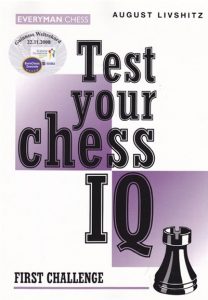
This book takes active solving to the next level, allowing readers to figure out their “tactics IQ” (estimated elo rating) based on their performance on the tests. When I worked through this book, the format pushed me to treat the puzzles as a serious test of my abilities, which made me more invested and focused. Another benefit of the book is: There are two more books to the series, Master Challenge (Although, I’d say the tactics are closer to expert level) and Grandmaster Challenge (which is about master-level). When you finish the first book, you can work on increasingly more difficult material. If you find First Challenge too difficult (it definitely requires some previous tactical training), try 1001 Winning Chess Sacrifices and Combinations by Fred Reinfeld first. After you finish that book, you’ll be better prepared for First Challenge.
Tactics for Advanced Players
by Yuri Averbakh
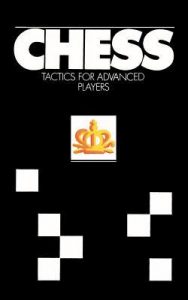
I recommend this book after Test Your Chess IQ: First Challenge. Averbakh does an excellent job of breaking down the different facets of tactical play. In addition, the book also has a very wide range of tactics. No matter what level you are, some will be easy, some will be moderate, and some will be very challenging.
Middlegame Strategy
by Aron Nimzowitsch
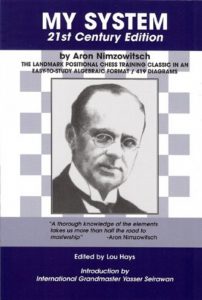
“Even in today's hypermodern age, it is very important for chess players to know their classics and educate themselves with games from previous generations. This can be difficult to remember in the age of 3400 rated engines, but the rewards are very tangible.” -GM Sam Shankland after winning the 2016 Biel Masters with a 2800+ performance rating
When I was young, it was a given everyone over 2200 had, at some point, read My System by Aron Nimzowitsch, the father of positional chess. The book had a marked effect on me and was greatly responsible for my improvement from the low 1500s to 1800+ over one study-heavy summer.
Capablanca’s Best Chess Endings
by Irving Chernev
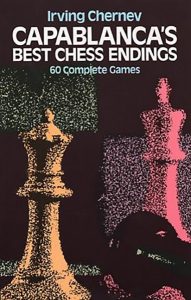
“Capablanca was among the greatest of chess players, but not because of his endgame. His trick was to keep his openings simple, and then play with such brilliance in the middlegame that the game was decided - even though his opponent didn't always know it - before they arrived at the ending.” -Bobby Fischer
Although it has an emphasis on the endgame, this book shows Capablanca games from start to finish, making it very instructive in middlegame play as well. For those new to studying GM Game collections, I highly recommend starting with Capablanca. He approached each position with a unique clarity. His ideas are usually easy to understand and very helpful for improvement.
“In just one game Capablanca will give you a master class about quick development, centralization, an open file, a "backward" pawn, an outpost and pins!” -GM Gregory Serper, “Carlsen, Capablanca, and the Beatles”
Going back to Chris' initial question---After Capablanca, Tal and Petrosian are great choices to study and two of my favorite players in history. Tal's autobiography is a very good book, but Tal-Botvinnik (1960) is his masterpiece---although it's more geared for expert level and above. Although I haven't read Python Strategy specifically, I would definitely also recommend the study of Petrosian. My positional understanding made a leap when I studied the 9th World Champion's games.
Reassess Your Chess, 4th Edition
by IM Jeremy Silman
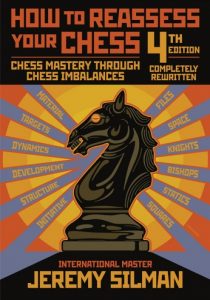
It’s pretty much impossible to list the best middlegame books for class B players without mentioning Reassess Your Chess. In his usual lively and entertaining style, Silman describes the relevant imbalances of a position and offers very clear examples of how to use them. Note: If you have an earlier edition, the 4th one is completely revamped. Although the overarching positional themes and principles are similar, the approach and examples are all brand new.
Endgames
Just the Facts! Winning Endgame Knowledge in One Volume
by GM Lev Alburt and GM Nikolay Krogius
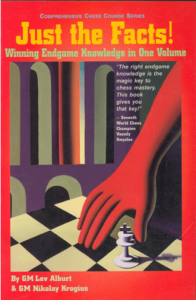
"You should be able to read a chess book without squinting, without forever flipping pages back and forth to find the relevant diagram, and without trying to keep a 12-move variation in your head.
We've tried to produce Just the Facts in a way that makes it enjoyable for you to get the most out of the unique instruction it contains. Look for color-coded diagrams and "break-outs" that call your attention to the most important positions and ideas. These will be especially worth revisiting and committing to memory."
-GM Alburt and GM Krogius
Just the Facts! aims to make studying the endgame light and entertaining. The book emphasizes key principles and theoretical positions in an energetic style, full of images, photographs, and historical backdrop to some of the best endgame players ever. It works well as an endgame primer or second book.
Silman’s Complete Endgame Course
by IM Jeremy Silman
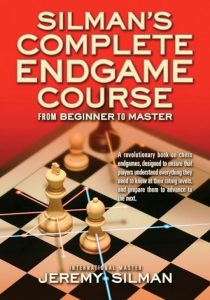
"Most chess writers think that chess players want as many positions as possible in an endgame book. And that sounds like a good idea! Give the chess hopeful the most bang for the buck! Stuff everything into one book!
This would be reasonable for an endgame encyclopedia, and such books are good research tools. But must every chess author daze his readers with this kind of 'overkill'? Of course not!
In fact, more than one player has been demoralized by the sheer mass of information that many endgame books offer---it all seems so dull and so hard to grasp.
Pondering this led me to ask an important question: How can the whole endgame genre be done differently?
By offering instruction that's tailor-made to fit a player's individual rating group, and is in accord with that player's future goals, I make endgame study easy to grasp and extremely practical for players and coaches."
-IM Jeremy Silman, Silman's Complete Endgame Course, "Preface"
A unique and very useful feature of this book is that the chapters are based on the reader's rating class, highlighting the essential knowledge for each level. This makes endgame study efficient and to-the-point.
When reading this book, I recommend studying the endgames up to one rating level above your own.
Grandmaster Secrets: Endings
by GM Andy Soltis
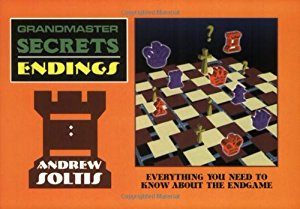
"I wondered if you could write a book teaching the endgame by means of Socratic dialogue.
I visualized a conversation, punctuated by diagrams and simple analysis. It was going to be a master talking at length with a young player who already knew all the Trends In The Whatsisname Attack and who could improvise through most middlegames---but who suddenly collapses in the endgame.
My idea was that by means of Q&A the master and this endgame-challenged amateur could arrive at certain eternal truths about endings and understand why they are true. I knew enough Class B players that they have heard about zugzwang or triangulation or the checking distance of a rook, yet didn't appreciate how or why these things could work in their own games."
-GM Andy Soltis, Grandmaster Secrets: Endings, "Preface"
This is a book I had trouble putting down. In a unique and fascinating style---full of quotes, visual aids, and humor---Soltis explains the very core of what’s important in the endgame.
It's an intermediate level book, so I recommend it after you have a couple more basic endgame books under your belt.
3) Focus on the middlegame and endgame.
“We gave fundamental consideration to physical preparation that would give me better chances of having a fresh mind in such a tiring match, rather than generating two suitcases of theoretical novelties.” -Mikhail Tal when describing his preparation for his World Championship Match in Tal-Botvinnik (1960)
Growing up, I was always the opposite of the stereotypical youth chessplayer. I studied the opening very, very little (to a flaw). While I was absolutely enthralled by an imaginative tactic, a flawless positional grind, or a clever endgame, I just couldn’t get myself interested in the opening stage of the game. Whenever I did study opening theory, I felt like I was “taking the road more often traveled”---blindly copying what’s been done before. I wanted to create. I wanted to think for myself from move one. Even though this point of view was unrealistic, it was useful for me at the time. While I paid nearly zero attention to the latest theory, I immersed myself in the study of chess itself: the classics, endgame studies, and tactics. I believe this study regimen is close to ideal for players between 1500-1900. My greatest improvements when I was in the Class C-A range were almost entirely due to increased knowledge in middlegame and endgame strategy and tactical ability. Even at the master level and above, where opening knowledge becomes more important, it doesn't make or break that many games. A few months ago, I faced an IM in an opening variation I was well prepared for. He forgot the line around move 9 and made a logical developing move instead of the main move. Yet, he went on to outplay me, winning comfortably. Opening knowledge or not, the better player tends to win. For players in the 1500-1900 rating range, as a guideline, I’d recommend dividing your study time into something like this:
- 35% middlegame strategy (positional, attack & defense)
- 25% tactics
- 20% endgames
- 15% analyzing your games (from tournaments and practice)
- 10% openings
Of course, the ideal percentages will vary slightly for everyone. Whenever you analyze your games (with a teacher, computer, or even on your own), take note of the areas where you have weaknesses and the types of positions you feel uncomfortable in. Zero in on these areas. For example: If you keep miscalculating, emphasize tactics. If you're uncomfortable when your opponent is attacking your king, don't just change to a more solid opening---Become a better defender. If you find yourself unsure of how to play certain endings, immerse yourself in the games of the great endgame masters of the past. Use your tournament games to identify your weaknesses. Turn them into strengths.
“After the 141-move blunderfest, I went off into a hole somewhere and studied rook endgames. Like, for serious. I got into rook endgames like a college freshman who has just discovered Bob Marley and lava lamps. I bought a bunch of Irving Chernev books for less than a dollar each off Amazon and played through dozens of Capablanca games… Fast forward five years to the 2014 Chicago Open. I go undefeated with four wins and three draws, scoring 5.5/7 in the Under 2300 section, tying for second. Five of the games are rook endings: two wins, three draws. It was around this time I started to feel like a magician with my rooks. Even down a pawn in complex scenarios, I was drawing easily. Equal pawns you had to be careful or I’d squeeze. Up a pawn it’s all over but the crying. That’s how I felt: give me the slightest edge in rook-and-pawn, and I’ll wave my wand and mystify you with my excruciatingly acquired knowledge gained on my deep spiritual journey into the depths of rooks endings.... I knew every idea, every in and out, every way to maximize the potential of the ending.” -Pete Karagianis, “The Stillwater Effect”, ChessLife Magazine August 2016
4) Change the way you study the opening.
Eventually, I came to terms with studying theory. And I learned more engaging and effective ways to do so. Over time, I realized that openings can enhance creative opportunities by providing fascinating positions to enter the middlegame with. Here are the situations where investing time in opening study is worth it:
- Whenever you forget or misplay an opening in a game, look it up afterwards. Because you ran into it in a game and have real life experience in the variation, you’ll remember the correct moves better next time.
“You should try to expand on your [opening] knowledge by a small amount, even just one more move. You can do this after a weekend tournament by collecting your scoresheets and reviewing your games. Even better is to look over a game shortly after it is ended. 'The best time to study an opening is immediately after a game because then the stimulus to learn is at its peak,' wrote Tim Harding and Leonard Barden.” -GM Andy Soltis, Studying Chess Made Easy
- Study the middlegames and endgames that arise from your openings through illustrative GM games.
- Use an opening book aimed at demonstrating an opening's ideas, such as the First Steps or the Move by Move series.
- Use a database. Set-up the position after 8-10 moves of the main line and look over strong GMs who’ve played your side.
I discuss studying the opening more extensively in the article, "How to Really Learn an Opening".
5) Practice.
"When you get to apply---in a real game---what you've learned from a book or computer screen, the information is reinforced in a powerful way." -GM Andy Soltis, Studying Chess Made Easy
You can practice for every aspect of a chess game. Training games give you a chance to work out the kinks in your play before there’s more on the line at a tournament. It’s a great opportunity to try out a new skill you’ve developed or an unfamiliar opening system. Blitz games are great for practicing openings, especially testing to see if you really remember the main variations. In addition, if you’re the kind of player that can’t help but get into time trouble (like me), they can prepare you for when your clock inevitably sinks below 5 minutes in tournament games. Longer practice games can be even more useful, allowing you to evaluate your grasp of new strategic ideas (especially in the middlegames that arise from your openings) and tactical sharpness. Even practicing theoretical endgames against a training partner or computer can be very effective:
"I was sitting in a car and commented to my friend that I wasn't 100% sure if I would be able to mate with bishop and knight vs. king. (I hasten to add this was a long time ago!) He showed me the procedure on a pocket set. When I got home, I practiced the mate against an engine until I could mate the bare king in 10 seconds from any position. The very next day I played a weekend tournament. In the first game, I reached bishop and knight vs. king and mated my opponent. I recall him leaning across the board and saying, 'Do you know how to do this?' My honest reply, 'Yes, I learned this yesterday,' failed to amuse him." -GM Jonathan Hawkins, Amateur to IM: Proven Ideas and Training Methods
Remember that improvement takes time.
“You work for a long period of time and the results don't really show, but at some point everything just comes together and you start to play better or get more confidence.” -GM Fabiano Caruana, currently ranked #2 in the world
Have a chess-related question for US Chess writer, Vanessa West? Let us know in the comments.
About the Author
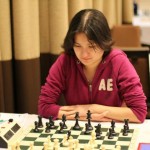 Vanessa West is a regular writer and digital assistant for US Chess News. She won the 2017 Chess Journalist of the Year award. Follow her on Twitter: @Vanessa__West
Vanessa West is a regular writer and digital assistant for US Chess News. She won the 2017 Chess Journalist of the Year award. Follow her on Twitter: @Vanessa__West
Categories
Archives
- June 2025 (24)
- May 2025 (24)
- April 2025 (29)
- March 2025 (29)
- February 2025 (20)
- January 2025 (24)
- December 2024 (34)
- November 2024 (18)
- October 2024 (35)
- September 2024 (23)
- August 2024 (27)
- July 2024 (44)
- June 2024 (27)
- May 2024 (31)
- April 2024 (51)
- March 2024 (34)
- February 2024 (25)
- January 2024 (26)
- December 2023 (29)
- November 2023 (26)
- October 2023 (37)
- September 2023 (27)
- August 2023 (37)
- July 2023 (47)
- June 2023 (33)
- May 2023 (37)
- April 2023 (45)
- March 2023 (37)
- February 2023 (28)
- January 2023 (31)
- December 2022 (23)
- November 2022 (32)
- October 2022 (31)
- September 2022 (19)
- August 2022 (39)
- July 2022 (32)
- June 2022 (35)
- May 2022 (21)
- April 2022 (31)
- March 2022 (33)
- February 2022 (21)
- January 2022 (27)
- December 2021 (36)
- November 2021 (34)
- October 2021 (25)
- September 2021 (25)
- August 2021 (41)
- July 2021 (36)
- June 2021 (29)
- May 2021 (29)
- April 2021 (31)
- March 2021 (33)
- February 2021 (28)
- January 2021 (29)
- December 2020 (38)
- November 2020 (40)
- October 2020 (41)
- September 2020 (35)
- August 2020 (38)
- July 2020 (36)
- June 2020 (46)
- May 2020 (42)
- April 2020 (37)
- March 2020 (60)
- February 2020 (38)
- January 2020 (45)
- December 2019 (35)
- November 2019 (35)
- October 2019 (42)
- September 2019 (45)
- August 2019 (56)
- July 2019 (44)
- June 2019 (35)
- May 2019 (40)
- April 2019 (48)
- March 2019 (61)
- February 2019 (39)
- January 2019 (30)
- December 2018 (29)
- November 2018 (51)
- October 2018 (45)
- September 2018 (29)
- August 2018 (49)
- July 2018 (35)
- June 2018 (31)
- May 2018 (39)
- April 2018 (31)
- March 2018 (26)
- February 2018 (33)
- January 2018 (30)
- December 2017 (26)
- November 2017 (24)
- October 2017 (30)
- September 2017 (30)
- August 2017 (32)
- July 2017 (27)
- June 2017 (32)
- May 2017 (26)
- April 2017 (37)
- March 2017 (28)
- February 2017 (30)
- January 2017 (27)
- December 2016 (29)
- November 2016 (24)
- October 2016 (32)
- September 2016 (31)
- August 2016 (27)
- July 2016 (24)
- June 2016 (26)
- May 2016 (19)
- April 2016 (30)
- March 2016 (37)
- February 2016 (27)
- January 2016 (33)
- December 2015 (25)
- November 2015 (23)
- October 2015 (16)
- September 2015 (28)
- August 2015 (28)
- July 2015 (6)
- June 2015 (1)
- May 2015 (2)
- April 2015 (1)
- February 2015 (3)
- January 2015 (1)
- December 2014 (1)
- July 2010 (1)
- October 1991 (1)
- August 1989 (1)
- January 1988 (1)
- December 1983 (1)







